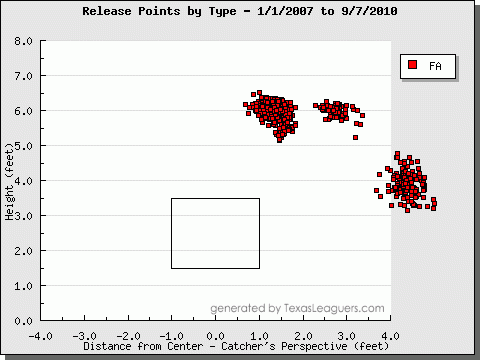
| Touching Bases | September 09, 2010 |
Jeff Sullivan in this very space on January 19, 2006:
We know an awful lot about pitchers. We know how hard they throw, how many batters they strike out, what kinds of pitches they have, and whether their deliveries are fluid and easy or violent and rough. This is all objective and indisputable information that has a lot of value when it comes to projecting a pitcher's future health and success.One thing we don't know much about, though, is the consistency of a pitcher's release point. The fact that we don't have a good way of measuring what's arguably the most important part of being a good pitcher is one of the more ironic twists of modern analysis.
Well, by 2007, PITCHf/x had become all the rage. The data is available now, but I'm not sure how widely release points have been studied.
PITCHf/x estimates the ball's location at a mark 50 feet from home plate. Pitchers often shift their spot on the rubber, resulting in variations of the horizontal component of the release point. This doesn't doesn't necessarily mean that the pitcher isn't repeating his delivery, though. Therefore, I decided to only look at the vertical component. Furthermore, some pitchers use different arm slots for different pitch types, and curveballs have a higher initial trajectory than fastballs. My methodology was the find the standard deviation of a pitcher's vertical release point for the fastest 20% of his pitches. Since cameras are calibrated ever so slightly differently in every ballpark, and even in every series to some extent, I looked at pitchers at both the season and game level.
While intuitive reasoning would suggest release point consistency is automatically a positive, I didn't immediately notice anything that would allow for such a broad claim. Still, I did see how release point consistency correlates with some other things.
Pitchers with lower arm slots have more trouble with release point consistency. This makes sense because pitchers with low arm angles tend to be less skilled and practiced than more traditional over-the-top pitchers. The sidearm motion could be naturally harder to repeat. It could also be a PITCH/x issue. Higher variance in release points coincide with higher variance in movement and velocity as well.
On to some examples. Javier Lopez, a sidearmer, is the worst at maintaining a consistent release point.

Perhaps he's changing his arm slot intentionally. Jose Contreras has been an effective pitcher who deals from multiple release points. Unlike Lopez, though, Contreras has separate, consistent release point clusters, which makes it easy to see that it is part of his approach.

And now for something different, Alberto Castillo:

David Huff is a good example of a pitcher who has a very consistent release point.

In fact, Frank Viola said in 2009, ""Huff has textbook mechanics. Everything is right there. His release point is consistent with all his pitches."
Chris Carpenter and Kevin Slowey have consistent release points, too.
Comments
I see where Alberto Castillo has faced 51 batters this season and given up FIVE home runs, four to LHB. Can you identify the release points on those home runs?
Posted by: Rich Lederer at September 8, 2010 10:39 PM
Rich, he gave those up to quality LHB power hitters at least. Branyan, Overbay, Ortiz, and Cano. All were first-pitch swinging, except Cano who fouled one off and then went yard. All much different release points. Sliders to Branyan and Overbay, fastballs to Cano and Ortiz.
Posted by: Jeremy Greenhouse at September 9, 2010 7:00 AM
Very interesting analysis. I'm curious if correlation can be drawn between release point and run value.
I think it could be interesting as well, to see how run value changes as the release point gets further away from the strike zone, to see a pitcher like Randy Johnson can owe some of his success to his ability to release from far outside the zone.
Posted by: Josh T. at September 9, 2010 8:23 AM
Castillo's really interesting. Does he keep his different release points consistent for the pitches he's throwing? When I've watched him, I don't remember him throwing any sliders from the low angle, just a mid-80s sinker.
Posted by: Lucas Apostoleris at September 9, 2010 1:49 PM